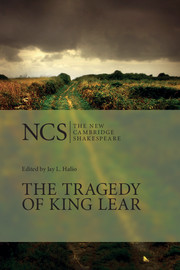Preface
Summary
For over two hundred years editors of King Lear have based their work on the theory that the two early texts of the play, the first quarto of 1608 and the Folio of 1623, represent incomplete and faulty approximations of the play as Shakespeare originally wrote it. This single-text theory, so-called, is in the judgement of many scholars today no longer viable. In their view, an alternative theory – that Q and F (as they are known) represent different versions of the play – must replace it. These scholars believe that the quarto, poorly printed by Nicholas Okes's compositors in the winter of 1607–8, derives from an early manuscript copy in Shakespeare's hand, and that the Folio derives from a considerably altered and revised version, one more closely approximating the play as the author visualised it in performance, or as the King's Men actually staged it in the period between its first performances and the third decade of the seventeenth century.
The implications of the alternative, or revision, hypothesis are significant for a modern editor, whomust nowdecide which version to followas his copy-text. The advocates of a quarto-based edition have strong arguments to support them; so do those who advocate a Folio-based edition. Final choice will depend upon one's preference for an early manuscript version, as reflected in the first printed edition, however corrupt or incomplete, or for a revised version of the play which, though in many respects offering a better text, involves problems of its own. Among those problems is the vexed question of revision and the issue of authenticity or legitimacy that revision, including authorial revision, raises.
Recently revision and the issue of intentionality it involves have also come under renewed scrutiny by theoretical and practical critics alike. If years have passed between the original composition and the revision (in the case of King Lear, perhaps more than five years), may it not be argued that the original creative impulse and sense of design have long since vanished, that the author can no longer be sure what he intended? My colleague, Hershel Parker, has asked just such questions and provided answers to them in his stimulating enquiry, Flawed Texts and Verbal Icons (1984).
- Type
- Chapter
- Information
- The Tragedy of King Lear , pp. xi - xiiiPublisher: Cambridge University PressPrint publication year: 2005

